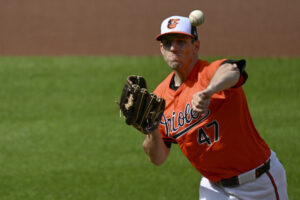Comebacks are fun to talk about and to read about. Now that we’ve gotten one under our belts, this writer can officially say that they are fun to write about. Comebacks are ageless. They intrigue our minds and bolster our sports fan constitutions. Depending upon where one lies as a fan, they can also make or break our belief in various teams. Many a strong team supporter has been made by one squad’s massive efforts in victory. That said, many of the same have felt angered, frustrated, and even betrayed by their team’s will to give games away. Simply put, comebacks affect us in so many different ways.
Today, we examine a game that happened way back in 1934. On a Tuesday afternoon in August, two teams met at Shibe Park in Philadelphia. One team, the Philadelphia Athletics, was on a downward spiral. The other team, the Cleveland Indians, were looking for a postseason berth. One out-hit the other 18-9 and still lost the game. Number nine in our countdown is one of the greatest bullpen collapses of all time. Comebacks are fueled by many different things, however today we will see how the simple act of throwing strikes is so very important.
August 21, 1934: Athletics vs. Indians
As a whole, the 1934 Athletics were unbalanced, despite being led by Hall of Famer Connie Mack. One of the best offenses in the game tried to mesh with one of the worst pitching staffs. They placed third in team average while leading the league in homers and slugging percentage. Hall of Famer Jimmie Foxx paced the team with 44 homers and a .334 average. He also walked 111 times, leading to an OBP of .449. Doc Cramer, Pinky Higgins, and Bob Johnson all had averages over .300 as well. Johnson added 34 long balls of his own.
Meanwhile, the pitching staff put up some of the worst numbers in the game. A 5.01 team ERA put them nearly last in the league. They only had two pitchers post ERA+ marks over 100. This pair combined to pitch in a measly seven games. Team ace Johnny Marcum won 14 contests, but a 4.50 ERA put a damper on that. In short, these Athletics were different, and not in a good way.
The Better Team
However, surprisingly, they are not the subjects of this particular comeback. No, it was the Indians, who were absolutely the better team that season. A powerful combination of Hall of Famer Earl Averill and Hal Trosky led the offense. They combined for 66 of Cleveland’s 100 home runs that year. Both hit well over .300 and had the same OPS+ of 150. Then there was second baseman Odell Hale’s 101 RBI campaign, along with outfielder Joe Vosmik’s .341 average. This Indians team was built to hit the ball, both for contact and with power. Pitching wise, their corps was among the best in the American League. In this particular season, a team ERA of 4.28 was good enough for third in the league. They also gave up the fewest home runs out of any staff (70).
A Shocking Start
So, it came as no surprise when this bustling Cleveland machine took an early lead. In the second inning, Athletics starter Al Benton allowed two quick baserunners. After an out, Cleveland catcher Moe Berg scored Hale with a single. Two batters later, outfielder Milt Galatzer got another hit to plate two more runs. Things were falling apart fast for Philadelphia once again. However, hope springs eternal in this often wild sport, and the Athletics soon charged back. A four run third, topped off by Higgins’s 12th home run, made it 4-3 in their favor. In the bottom of the fifth, pitcher Benton picked up an RBI, making it 5-3.
Suddenly, the Indians’ pitching staff looked like the weaker unit. Two more runs came across in the sixth, followed by four in the seventh. In short, the Athletics had scored 11 runs and banged out 18 hits by the time the top of the ninth came around. Benton had settled in as well, retiring seven in a row heading into the inning. Hall of Fame manager Connie Mack chose to stick with Benton as Knickerbocker came up to lead off for the Indians. He promptly got a leadoff hit and set off one of the biggest pitching collapses ever.
Walking the World Fuels Comebacks
As far as comebacks go, this one was keyed by one thing…the walk. Normally, it’s something that is seen as trivial by a lot of people. After all, one might assume, it is not a given that every hitter who walks will automatically score. However, this writer has often personally postulated that a walk does more damage than a solo home run. It gives the opponent free baserunners and a much easier time scoring. On this day, when it came to the Athletics, this particular theory rang truer than ever. After Knickerbocker’s hit, six consecutive Indians walked. It began with Willie Kamm, followed by Berg. Mack must not have sensed danger, for he left Benton in the game. Frankie Pytlak was given the third straight free pass to make it 11-4.
This caused Mack to remove Benton and put in Joe Cascarella. He issued back to back walks to Galatzer and Sam Rice, making the score 11-6. Once more, Mack went to his bullpen, calling upon right hander Sugar Cain to stop the bleeding. Unfortunately, Cain only added to it, issuing the sixth straight walk to Averill, making it 11-7. Trosky then grounded out, however this plated the eighth Indians run. Hale drove Rice in with a single, and Knickerbocker picked up his second hit of the inning. Trosky scored on the hit and Hale scored thanks to an error by third baseman Higgins. It was now tied at 11, and Mack went to the bullpen for a third time and put in closer Roy Mahaffey. He promptly gave up a go ahead hit to Kamm before finally getting Bob Seeds to ground into a double play. The Indians picked up nine runs on a mere four hits. Final score: Indians 12, Athletics 11.
Comebacks: Moral of the Story
In our tenth comeback, we discussed how playing good defense is tantamount to a team’s success, especially with a large lead. Here, we see an exercise in the utilization of one’s bullpen and the team’s ability to throw strikes. True, the Indians had a solid offense that year. However, simply throwing the ball over the plate would have led to an easy win for Philadelphia. The Indians had a 0.05% chance to win in the bottom of the eighth inning. They left the ninth with a 78% chance to win. Here, the moral is simple: practicing good pitching fundamentals wins ballgames.
Main Photo:
Embed from Getty Images
Players/Managers Mentioned:
Connie Mack, Jimmie Foxx, Doc Cramer, Pinky Higgins, Bob Johnson, Johnny Marcum, Earl Averill, Hal Trosky, Odell Hale, Joe Vosmik, Al Benton, Moe Berg, Milt Galatzer, Willie Kamm, Frankie Pytlak, Joe Cascarella, Sam Rice, Sugar Cain, Roy Mahaffey, Bob Seeds






